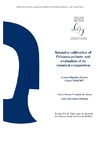Identificador persistente para citar o vincular este elemento:
https://accedacris.ulpgc.es/jspui/handle/10553/74981
| Campo DC | Valor | idioma |
|---|---|---|
| dc.contributor.advisor | Gómez Pinchetti, Juan Luis | es |
| dc.contributor.advisor | Trindade De Abreu, María Helena | es |
| dc.contributor.author | Figueira García, Laura | es |
| dc.date.accessioned | 2020-10-23T14:40:43Z | - |
| dc.date.available | 2020-10-23T14:40:43Z | - |
| dc.date.issued | 2017 | en_US |
| dc.identifier.uri | https://accedacris.ulpgc.es/handle/10553/74981 | - |
| dc.description.abstract | Seaweed based Integrated Multi-Trophic Aquaculture (IMTA) systems are being designed to mitigate the environmental problems caused by several forms of fed aquaculture. A seaweed cultivation system using 127 and 230 L tanks was used to cultivate Palmaria palmata (Rhodophyta). Palmaria palmata is a cold temperate species of the North Atlantic and North Pacific Oceans. In the present study Palmaria palmata could grow throughout the entire course of the experiment and under all conditions tested. The highest RGR value (3,13 % ± 0,40) was observed from Palmaria palmata cultivated under a density of 1 kg m-2. Under winter conditions the productivity value reach the maximal value of 26,89 ± 19,02 g(dw) m-2 week−1. The total lipid, protein, ash, carbohydrates and individual fatty acid contents of Palmaria palmata were determined (fatty acids by gas chromatography). Total lipid content ranged from 0,00389 ± 0,0003 to 0,00987 ± 0,00030 (% ± se). The most abundant fatty acids were C16:0, C18:0 and C20:5. Ash content ranged from 14,5 ± 0,67 to 24,2 ± 0,86 (% ± se), protein content from 17,3 ± 0,05 to 24,8 ± 0,02 (% ± se) and carbohydrates from 55,52 to 67,56%. | en_US |
| dc.description.abstract | La Acuicultura Multi-Trófica Integrada (AMTI) está basada en algas para mitigar los problemas ambientales causados por los procesos desarrollados en la acuicultura moderna. Se utilizó un sistema de cultivo de algas utilizando tanques de 127 y 230 L para cultivar Palmaria palmata (Rhodophyta). Palmaria palmata es una especie de temperatura fría del Atlántico Norte y del Océano Pacífico Norte. En este estudio, Palmaria palmata fue capaz de crecer a lo largo de todo el experimento y bajo todas las condiciones testadas. El mayor valor de la tasa relativa de crecimiento (3,13% ± 0,40) se observó a partir de Palmaria palmata cultivada bajo una densidad de 1 kg m-2. En condiciones invernales, el valor de productividad alcanza el valor máximo de 26.89 ± 19,02 g (peso seco) m-2 semana-1. Se determinaron los contenidos totales de lípidos, proteínas, cenizas, carbohidratos y ácidos grasos individuales. (Ácidos grasos mediante cromatografía de gases). El contenido total de lípidos osciló entre 0,00389 ± 0,0003 y 0,00987 ± 0,00030 (% ± se). Los ácidos grasos más abundantes fueron C16:0, C18:0 y C20:5. El contenido de cenizas varió de 14,5 ± 0,67 a 24,2 ± 0,86 (% ± se), contenido de proteína de 17,3 ± 0,05 a 24,8 ± 0,02 (% ± se) y carbohidratos de 55,52 a 67,56%. | en_US |
| dc.language | eng | en_US |
| dc.subject | 241707 Algología (ficología) | en_US |
| dc.subject.other | Palmaria palmata | es |
| dc.subject.other | Cultivation | es |
| dc.subject.other | Productivity | es |
| dc.subject.other | Chemical composition | es |
| dc.subject.other | Fatty acids | es |
| dc.title | Intensive cultivation of "Palmaria palmata" and evaluation of its chemical composition | es |
| dc.type | info:eu-repo/semantics/bachelorThesis | en_US |
| dc.type | BachelorThesis | en_US |
| dc.contributor.departamento | Departamento de Biología | es |
| dc.contributor.facultad | Facultad de Ciencias del Mar | en_US |
| dc.investigacion | Ciencias | en_US |
| dc.type2 | Trabajo final de grado | en_US |
| dc.utils.revision | Sí | en_US |
| dc.identifier.matricula | TFT-42280 | es |
| dc.identifier.ulpgc | Sí | en_US |
| dc.contributor.buulpgc | BU-BAS | es |
| dc.contributor.titulacion | Grado en Ciencias del Mar | es |
| item.grantfulltext | open | - |
| item.fulltext | Con texto completo | - |
| crisitem.advisor.dept | GIR IOCAG: Oceanografía Biológica y Algología Aplicada | - |
| crisitem.advisor.dept | IU de Oceanografía y Cambio Global | - |
| crisitem.advisor.dept | Departamento de Biología | - |
| Colección: | Trabajo final de grado Restringido ULPGC | |
Visitas
273
actualizado el 31-oct-2024
Descargas
382
actualizado el 31-oct-2024
Google ScholarTM
Verifica
Comparte
Exporta metadatos
Los elementos en ULPGC accedaCRIS están protegidos por derechos de autor con todos los derechos reservados, a menos que se indique lo contrario.
